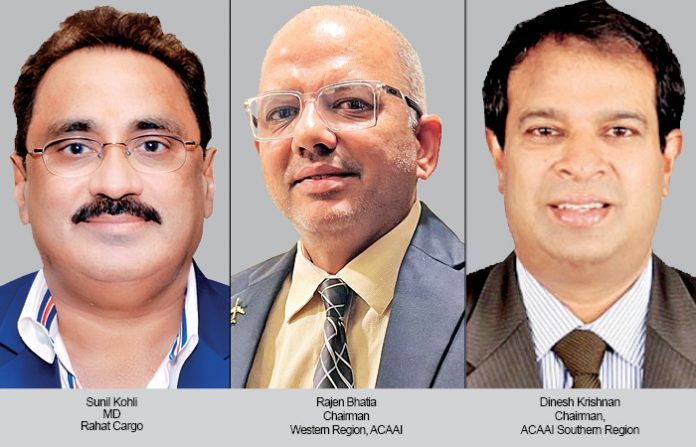Heavy downpour can cause waterlogging on tarmacs and loading areas, hindering movement of goods. Poor visibility may also slow down or temporarily halt cargo operations, affecting overall supply chain and leading to shipment backlogs. Industry experts spoke to CARGOTALK on this troublesome issue.
CT Bureau
Imagine shipments containing high-value products lying in water-logged area outside airport terminal or at the tarmac waiting to be offloaded, with agents fearing potential loss or damage, high costs and transit times. Handling and transportation, especially during monsoon are common, despite having state-of-the-art infrastructure for cargo movement.
Let alone airports in tier II and III cities, airports in tier I cities such as Delhi, Mumbai, Hyderabad and Bengaluru also face similar problems. Cargo handling needs extra care to prevent moisture-related damage. First and foremost, packaging plays a vital role. Packaging firms must maintain the quality of materials and techniques to ensure safety of the precious cargo. The cargo handling staff must use waterproof covers, shrink wraps and tarpaulins in a bid to shield shipments from rain during loading and unloading. Pallets are elevated to avoid contact with wet surfaces and quick turnaround procedures to minimise exposure at the airport terminals.
Sensitive goods such as electronics, textiles and pharmaceuticals should be packed in moisture-resistant packaging and temperature-controlled containers. Coordination between airside and warehouse operators is crucial, ensuring cargo is moved swiftly and securely from aircraft to storage under covered or sheltered pathways always.
Sunil Kohli, MD, Rahat Cargo, said, “It becomes imperative that precautions are taken by the cargo handlers so that shipments do not get wet or damaged. Since monsoon rains is not a new phenomenon in India, the handlers must be fully aware as to how to ensure a safe packing of cargo to avert any damage to it from rains. They must be trained to load or unload cargo using covered platforms in a way that minimises exposure to rain and potential damage. Transportation during monsoon poses a challenge to the handlers as how to protect the cargo from the potential damage. Closed body vehicles (CBVs)need to be used for ferrying the goods. The transport service providers must take precautions by covering the truck with layers of tarpaulin and plastic sheets. They should be aware not to undertake outdoor loading or unloading in severe weather conditions to ensure safety.”
Expressing similar sentiments, Rajen Bhatia, Chairman, Western Region, ACAAI, asserted, “Cargo handlers, particularly those at major airports such as CSMIA, are trained to take special precautions during monsoon months. Mumbai is known for its intense rainfall, high humidity and flooding, necessitating proactive and adaptive handling procedures. Monsoon SOPs must be followed such as airports and ground handling agents must roll out monsoon-specific SOPs to all airside and landside cargo teams before the clouds open. Protective packaging and pallet wrapping is crucial as handlers are trained to ensure cargo is shrink-wrapped, covered with tarpaulin and placed on plastic or elevated pallets to prevent contact with water on the tarmac or warehouse floor. Handlers are given refresher training on how to act during a sudden downpouror waterlogging scenarios. Tarmac Transfer Protocols (TTPs) must be followed. Cargo movements from terminal to aircraft (or vice versa) are minimised during heavy showers or conducted using covered dollies and rapid transit vehicles. The handlers must be equipped with rain gear to ensure uninterrupted handling. Monsoons also pose challenges for cargo handlers; they are more pronounced at Mumbai, Chennai, and Kolkata, which experience heavy and prolonged rainfall.”
At the same time, Dinesh Krishnan, Chairman, Southern Region, ACAAI, said, “Monsoon is an annual event. It comes as no surprise if the cargo terminal operators (CTOs) pay attention to the ‘monsoon enabled’ terminal infrastructure in advance instead of the trade suffering due to wet cargo and the CTOs waking up to do patch work to fix the problems. At the Chennai cargo terminal, due to truck ramp and shed misalignment, the cargo gets wet, while loading and unloading in the trucks. At the import shed although a canopy is provided, the segregation is done outside so that the cargo gets wet. Even before the monsoon rain begin, airport terminal operators ensure multiple roofing, check for leakage in pipes, water backlog risks both import and export cargo.”
Disruptions
Exposure to rain water during unloading and loading of goods or when cargo is stationary on the tarmac will damage perishables, pharmaceuticals, electronics and high-value cargo. Low visibility due to heavy rain or fog can delay cargo operations and vehicle movement on the airside. It may lead to missed flight connections or delayed customs clearance. Slippery surfaces, puddles, or even temporary flooding around cargo bays and roads can cause accidents, tipping of unit load devices or damage to Ground Support Equipment (GSE).












